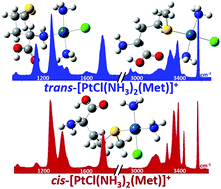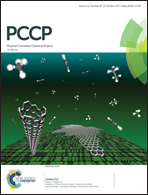Cisplatin and transplatin interaction with methionine: bonding motifs assayed by vibrational spectroscopy in the isolated ionic complexes†
Abstract
Cisplatin and transplatin (cis- and trans-[PtCl2(NH3)2]) have been allowed to react with methionine (Met) in water solution in a study aimed to characterize the monofunctional complex primarily formed. The thioether function of methionine is known to have a very high affinity for square planar platinum(II) and sulfur-containing biomolecules have been proposed as a cisplatin drug reservoir on the way to platination at DNA. Both cisplatin and transplatin yield [PtCl(NH3)2Met]+ complexes, delivered by electrospray ionization in the gas phase and sampled as isolated species using tools based on mass spectrometry. The collision induced dissociation spectra of both cis-[PtCl(NH3)2Met]+ and trans-[PtCl(NH3)2Met]+ are quite similar and also the transport properties assayed by ion mobility mass spectrometry do not allow any appreciable discrimination. However, the vibrational spectra obtained by IR multiple photon absorption (IRMPD) spectroscopy show distinct features. Their analysis, supported by quantum chemical calculations, has revealed that while cisplatin attack is mainly directed to the sulfur atom of Met, transplatin shows a more balanced partition between sulfur and nitrogen binding. Among the vibrational signatures characterizing cis-[PtCl(NH3)2Met]+ and trans-[PtCl(NH3)2Met]+ complexes, the asymmetric NH2 stretching of the α-amino group of the amino acid at ca. 3440 cm−1 is peculiar and diagnostic of S-platination. IRMPD kinetics evaluated at this frequency support the prevailing S-attack by cisplatin while approximately a 1 : 2 ratio of S- versus N-coordination is observed by transplatin, to be possibly related to the trans effect at the platinum center.



 Please wait while we load your content...
Please wait while we load your content...